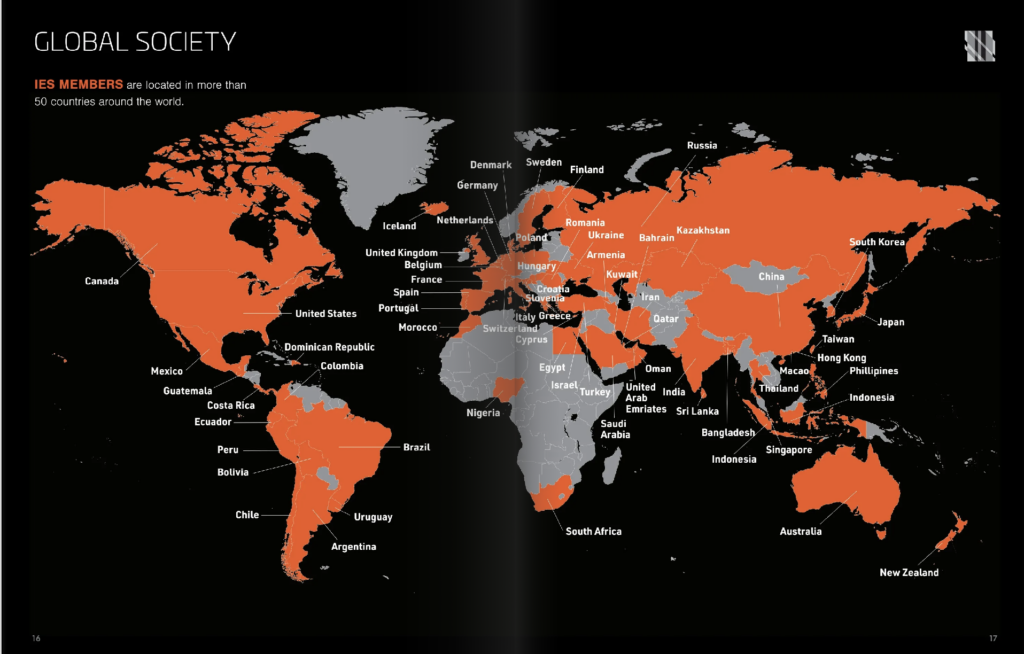Over the weekend, your humble editor read through the 2022-2023 IES Annual Report and there was some interesting information.These are tough times for the Society, and you would not know it from the Annual Report but I don’t fault them for putting their best foot forward in the report.
IES lists its core beliefs at the beginning of the report and it’s all good stuff:
- IES places light on par with life’s essentials like air and water, recognizing its impact on vision, health, and behavior. Lighting should enhance the built environment’s comfort and aesthetic while being environmentally considerate.
- IES emphasizes that lighting design should meet human needs and maintain quality from concept through construction. Research is key to substantiating the life-enhancing benefits of lighting.
- Standards for lighting must be scientifically grounded and expert-consensus-driven. Collaborative policymaking with varied organizations aligns with the public good.
- IES underscores the importance of global cooperation and member engagement for the lighting sector’s sustainability. Education is also deemed crucial for the community’s growth and dynamism.

The first three bullet points are things they have been doing for years and it’s good to see them in writing. The fourth bullet caught my eye as it talks about global cooperation and the Society, like the EdisonReport, believes that we live in a global lighting community and it’s good to see that they are not just focused on North America. Pages 16 & 17 show an impressive map of countries where IES has members. The map gives the impression that IES is as strong in Europe as it is in the United States. Again, nothing is misleading, as they are highlighting their strengths.
They list all the committees on pages 6 and 7, which is great to see in one place. I miss the old days when the committees met throughout the year, but they usually had one in-person meeting at the Annual Conference. It was enlightening to see the committees at work in real-time. If you were interested in a particular subject, you could sit in on the committee (non-voting) and see if it made sense to join. Now most committee meetings are conducted via Zoom and it’s a little more difficult to see what is going on and whether it makes sense to join a particular committee.
Page 15 lists the total Society membership at 5,492—which is higher than I thought, and I was very pleased to see the sustaining member numbers at 328—again, higher than I thought.
The financial review is where I spent the majority of my time. I attended an IES Board meeting in 2023 and saw the preliminary unaudited numbers for FY 2022-2023 and these percentages are in line with what I had seen earlier.
In my humble opinion, there are three significant financial issues.
One of the major problems was the Wall Street lease at approximately $50,000 per month. While I don’t know the financial details of the lease exit, good riddance! A footnote states, “With the Wall Street office lease termination and other operational efficiencies beginning in 2024, the IES’s expenses will drastically decrease to be more appropriate for a nonprofit of its size.” So problem number one has been addressed.
LightFair and the other conferences is financial problem #2. Conferences show a total income of $1,539,601, whereas Conference & Events show an expense of $1,775,442. There is no magic wand that will quickly fix LightFair, although Messe will bring new excitement and lower rates. But, just like ANDMORE, Messe will still have management fees. LightFair is on a better path, but the issue is not fixed.
At a board meeting in 2022, I heard the Chief Financial Officer, Olga Loukina, comment that IES should no longer host conferences where they know there will be a deficit. I could not agree more. The problem is that the Society inherited several Marriott contracts from the COVID period and let’s hope that after the IES2024, the Lighting Conference (Marriott Marquis-Time Square), and the SALC (Marriott Marquis—Atlanta), we can be finished with Marriott contracts.
The SALC should have a surplus this year, but I doubt The Lighting Conference will. Your humble editor recommends that the 2024 event be the last in-person Lighting Conference until the Society is at break even, especially given that almost no in-person committee work is conducted.
On Friday, the IES proved that they now know to conduct a hybrid virtual conference as they, along with The New School at Parson’s, did a wonderful job hosting the Light & Justice Symposium. Given this new-found expertise, a hybrid conference could be conducted with minimal cost.
Financial problem #3 is with publications. I don’t like that LD+A, Leukos, and Standards & Education are lumped together with a total income of $1,774,339 and expenses of $2,767,425. During the Board of Directors meeting which I attended, the preliminary numbers were broken out individually.
Now that the lease is fixed, other costs reduced and LightFair has a new path, it’s time for the Society to focus on this $993,086 publications deficit and identify which specific program(s) are responsible for the deficit.
Leukos and Standards and Education are key competencies of the Society—and those must be profitable!




